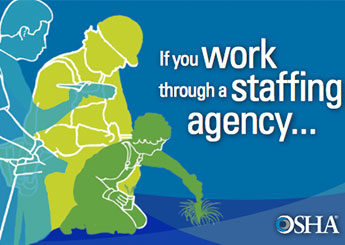Temp worker safety: New OSHA bulletins clarify training, hazcom requirements

Photo: OSHA
Washington – As part of its Temporary Worker Initiative, OSHA has released guidance documents intended to clarify training requirements and hazard communication responsibilities for employers of temporary workers.
One bulletin explains that the host employer and staffing agency share responsibility for training temp workers. It is up to the host employer and staffing agency to determine which of them handles each element of the training, the guidance states, adding that most of the time the staffing agency handles general safety and health training while the host employer conducts training specific to the worksite.
Other requirements: Workers must be trained before starting the job, and the training should be conducted in a language that the worker understands.
“Many OSHA standards include specific safety and health training requirements to ensure that workers have the required skills and knowledge to safely perform their work,” the guidance notes. “These requirements reflect OSHA’s principle that training is an essential part of an effective safety and health management program for protecting workers from injuries and illnesses. Many fatal incidents have occurred where temporary workers were not provided the training necessary to do their job safely.”
The bulletin also explains that both the staffing agency and host employer must ensure temp workers are trained on reporting work-related injuries and illnesses.
A second bulletin directs the host employer and staffing agency to complete hazard communication training before the temp worker starts work, and communicate when that training is finished. Training should be conducted each time a new chemical hazard is introduced.
“The host employer holds the primary responsibility for providing site-specific hazard communication information and training on chemical hazards in the workplace to temporary employees since it uses or produces the hazardous chemicals and creates and controls the work process,” the guidance states. “Staffing agencies must, at a minimum, provide generic hazard communication information and training to their employees to explain HCS requirements applicable to different occupational settings that the temporary employees are expected to encounter.”
The host employer must personal protective equipment as well, according to the guidance.
Both bulletins offer examples of what could happen if a worker does not receive adequate training.
Post a comment to this article
Safety+Health welcomes comments that promote respectful dialogue. Please stay on topic. Comments that contain personal attacks, profanity or abusive language – or those aggressively promoting products or services – will be removed. We reserve the right to determine which comments violate our comment policy. (Anonymous comments are welcome; merely skip the “name” field in the comment box. An email address is required but will not be included with your comment.)

